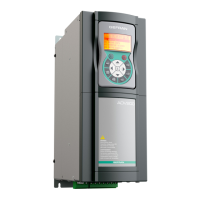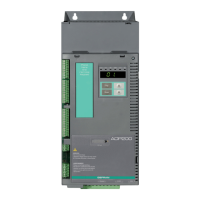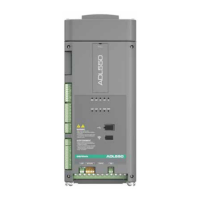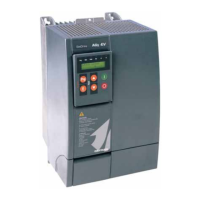ADL300 • Functions description and parameters list 35
5.6 – EMERGENCY MODE
The possibility of operating on an emergency module power supply has been implemented in the drive, to overcome the problem of
sudden power failures.
The emergency operation condition signal must be connected to the Emergency command input (digital input 3 as default) which,
if active, disables the undervoltage alarm so that the drive can operate powered on the DC link by the EMS emergency module
(which is in turn powered by a buer battery pack).
In order to use batteries with a lower power rating, a function has been implemented to allow the desired direction of travel to be
selected before starting an emergency start procedure.
The direction is selected after testing the movement in both directions, choosing the one that requires less current (for more details
see EMS manual).
In case of a blackout the drive can be powered by an Emergency Module Supplier (EMS) or by an Uninterruptible Power Supply
(UPS).
The emergency function signal must be connected to the input of the Emergency Mode command (default digital input DI3).
Operation with Emergency Module Supplier (EMS)
If digital input 3 DI3 is active, the Undervoltage (UV) alarm refers to the value set in parameter 448 (menu 4), allowing the drive to
run powered on the DC link. See the ADL300 Quick Start manual (paragraph 7.3.3) and the EMS Manual for the connection.
Operation with Single-phase Uninterruptible Power Supply (UPS)
When the emergency is activated by digital input DI3, the Drive can be powered by a 230V single-phase UPS. See the ADL300
Quick Start manual (paragraph 7.3.3) for the connection.
Arrival at oor in Emergency
For both closed-loop and open-loop congurations, arrival at the oor in an emergency is managed by trying to optimize the request
for current to the emergency modules.
The drive can select the more favorable direction for arriving at the oor without forward/reverse movements, thereby protecting the
parts in emergency.
Menu PAR Description UM Type FB BIT Def Min Max Acc Mod
5.6.1 11260 Speed emergency mode Hz FLOAT 5.00 3.40E+94 3.40E+94 RW FVS
Setting of the speed during movements in the emergency operation condition. Given the low voltage, high speeds cannot
be reached with the drive powered by battery (or emergency module). The speed selected in the multispeed parameter is
therefore ignored and this value is used instead.
Menu PAR Description UM Type FB BIT Def Min Max Acc Mod
5.6.2 11262 Autoselect direction BIT 0 0 2 ERW FVS
Enabling of automatic selection of preferred direction before an emergency start.
0 OFF
1 ON
2 Recommended
This parameter lets you select how the drive calculates the more favorable riding direction of the cabin when it is in emer-
gency mode.
If 0 is selected, the drive does not calculate the more favorable direction, which is commanded manually.
If 1 is selected, as soon as the drive is in emergency condition it moves the motor with alternating forward and reverse
movements, calculating the value of the current delivered in each direction, and selects the more favorable one (less cur-
rent requested).
If 2 is selected (recommended mode), the drive evaluates the more favorable direction without making alternating forward
and reverse movements (avoiding requests for current from the EMS or UPS), already knowing the more favorable direc-
tion because it had already calculated it based on the value of current delivered and on the DC-Link voltage. If the drive
was in regeneration before the emergency, it keeps the same riding direction in emergency; if the drive was not in regener-
ation but was delivering current at a value below the value set in parameter PAR 11284 Detection Limit, it keeps the same
riding direction. Otherwise, the drive changes riding direction and considers the previous one unfavorable.
Menu PAR Description UM Type FB BIT Def Min Max Acc Mod
5.6.3 11278 Em Dc brk current FLOAT 75.0 0 150 RW FVS
The parameter lets you set the braking current value by injecting DC in the motor windings. You can limit this value and
avoid overloading the emergency batteries.
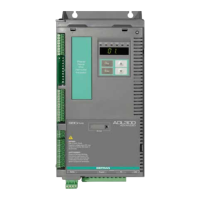
